Spectrum Summary: Civil Disobedience Movement & Round Table Conferences | History for UPSC CSE PDF Download
Introduction
Civil disobedience, rooted in nonviolent resistance against unjust laws, has shaped history. From Gandhi's Salt March to global movements, it challenges oppression and advocates for human rights. Understanding its principles and outcomes is crucial for insights into social and political dynamics, impacting governance and societal transformation.
The Run-up to the Civil Disobedience Movement
Calcutta Session of Congress
- It was at the Calcutta session of the Congress in December 1928 that the Nehru Report was approved.

- Congress decided that if the government did not accept a constitution based on dominion status by the end of the year, the Congress would not only demand complete independence but would also launch a civil disobedience movement to attain its goal.
Political Activity during 1929
- Gandhi traveled incessantly during 1929 preparing people for direct political action. The Congress Working Committee (CWC ) organized a Foreign Cloth Boycott Committee. Gandhi initiated the campaign in March 1929 in Calcutta and was arrested.
- This was followed by the bonfires of foreign cloth all over the country. Other developments that kept the political temperature high during 1929 included the Meerut Conspiracy Case (March), a bomb explosion in Central Legislative Assembly by Bhagat Singh and B.K. Dutt (April) and the coming to power of the minority Labour government led by Ramsay MacDonald in England in May.
Irwin’s Declaration (October 31, 1929)
- Declaration by Lord Irwin was made. It was the combined effort of the Labour government and a Conservative viceroy. The purpose behind the declaration was to “restore faith in the ultimate purpose of British policy''.
- Declaration was made in the form of an official communique in the Indian Gazette on October 31, 1929. Lord Irwin also promised a Round Table Conference after the Simon Commission submitted its report.
Delhi Manifesto
- Leaders issued a 'Delhi Manifesto' which put forward certain conditions for attending the Round Table Conference.
- that the purpose of the Round Table Conference should be not to determine whether or when dominion status was to be reached but to formulate a constitution for implementation of the dominion status and the basic principle of dominion status should be immediately accepted;
- that the Congress should have majority representation at the conference; and
- There should be a general amnesty for political prisoners and a policy of conciliation.
- Viceroy Irwin rejected the demands put forward in the Delhi Manifesto. The stage for confrontation was to begin now.
Lahore Congress and Purna Swaraj
- Jawaharlal Nehru was nominated the president for the Lahore session of the Congress (December 1929) mainly due to Gandhi's backing (15 out of 18 Provincial Congress Committees had opposed Nehru). Nehru was chosen
(i) because of the appositeness of the occasion and
(ii) To acknowledge the upsurge of youth that had made the anti-Simon campaign a huge success.

Following major decisions were taken at the Lahore Session
- Round Table Conference was to be boycotted.
- Complete independence was declared as the aim of Congress.
- Congress Working Committee was authorized to launch a program of civil disobedience including non-payment of taxes and all members of legislatures were asked to resign their seats. January 26, 1930, was fixed as the first Independence (Swarajya) Day, to be celebrated everywhere.
December 31, 1929
- At midnight on the banks of River Ravi, the newly adopted tricolor flag of freedom was hoisted by Jawaharlal Nehru amidst slogans of Inquilab Zindabad.
January 26, 1930: the Independence Pledge
- It is the inalienable right of Indians to have freedom.
- British Government in India has not only deprived us of freedom and exploited us, but has also ruined us economically, politically, culturally, and spiritually. India must therefore sever the British connection and attain purna swaraj or complete independence.
- We are being economically ruined by high revenue, destruction of village industries with no substitutions made, while customs, currency, and exchange rate are manipulated to our disadvantage.
- No real political powers are given—rights of free association are denied to us and all administrative talent in us is killed.
- Culturally, the system of education has torn us from our moorings.
- Spiritually, compulsory disarmament has made us unmanly.
- We hold it a crime against man and God to submit any longer to British rule.
- We will prepare for complete independence by withdrawing, as far as possible, all voluntary association from the British government and will prepare for civil disobedience through non-payment of taxes. By this, an end to this inhuman rule is assured.
- We will carry out the Congress instructions for purpose of establishing purna swaraj.
The Salt Satyagraha
Gandhi gave an ultimatum of January 31, 1930, to accept or reject these demands.
Issues of General Interest
- Reduce expenditure on Army and civil services by 50 percent.
- Introduce total prohibition.
- Carry out reforms in the Criminal Investigation Department (CID).
- Change Arms Act allowing popular control of the issue of firearms licenses.
- Release political prisoners.
- Accept Postal Reservation Bill.
Specific Bourgeois Demands
- Reduce rupee-sterling exchange ratio to 1:4
- Introduce textile protection.
- Reserve coastal shipping for Indians.
Specific Peasant Demands
- Reduce land revenue by 50 percent.
- Abolish salt tax and government's salt monopoly.
- With no positive response by February-end, Gandhi had decided to make salt the central formula for the movement
Why Salt was Chosen as the Important Theme
- Salt in a flash linked the ideal of Swaraj
- Salt afforded a very small but psychologically important income.
Dandi March (March 12-April 6,1930)
- On March 2, 1930, Gandhi informed the viceroy of his plan of action. According to this plan Gandhi, along with a band of seventy-eight members of Sabarmati Ashram, was to march from his headquarters in Ahmedabad through the villages of Gujarat for 240 miles.
- Gandhi gave the following directions for future action.
- Wherever possible civil disobedience of the salt law should be started.
- Foreign liquor and cloth shops can be picketed.
- We can refuse to pay taxes if we have the requisite strength.
- Lawyers can give up the practice.
- The public can boycott law courts by refraining from litigation.
- Government servants can resign from their posts.
- All these should be subject to one condition—truth and non-violence as a means to attain swaraj should be faithfully adhered to.
- Local leaders should be obeyed after Gandhi’s arrest.
- The historic march, marking the launch of the Civil Disobedience Movement, began on March 12, and Gandhi broke the salt law by picking up a lump of salt at Dandi on April 6.
The spread of Salt Disobedience
- Nehru's arrest in April 1930 for defiance of the salt law evoked huge demonstrations in Madras, Calcutta, and Karachi. Gandhi’s arrest came on May 4, 1930, when he had announced that he would lead a raid on Dharasana Salt Works on the west coast.
- After Gandhi’s arrest, the CWC sanctioned:
(i) non-payment of revenue in ryotwari areas;
(ii) the no-chowkidar-tax campaign in zamindari areas; and
(iii) Violation of forest laws in the Central Provinces.
Satyagraha at Different Places
- Tamil Nadu: In April 1930, C. Rajagopalachariorganised a march from Thiruchirapallito Vedaranniyam on the Tanjore (or Thanjavur) coast to break the salt law.
- Malabar: K. Kelappan, a Nair Congress leader famed for the Vaikom Satyagraha, organized salt marches.
- Andhra Region: District salt marches were organized in east and West Godavari, Krishna, and Guntur.
- Orissa: Under Gopalbandhu Chaudhuri, a Gandhian leader, salt satyagraha proved effective in the coastal regions of Balasore, Cuttack, and Puri districts.
- Assam: The civil disobedience failed to regain the heights attained in 1921-22 due to divisive issues
- Bengal: During the same period, Surya Sen’s Chittagong revolt group carried out a raid on two armories and declared the establishment of a provisional government.
- Bihar: Champaran and Saran were the first two districts to start salt satyagraha. In Patna, Nakhas Pond was chosen as a site to make salt and break the salt law under Ambika Kant Sinha. The tribal belt of Chhotanagpur (now in Jharkhand), saw instances of lower-class militancy.

- Peshawar: Gaffar Khan, also called Badshah Khan and Frontier Gandhi, had started the first Push to political monthly Pukhtoon and had organized a volunteer brigade Khudai Khidmatgars’, popularly known as the Red- Shirts’,
- Sholapur: This industrial town of southern Maharashtra saw the fiercest response to Gandhi’s arrest. Textile workers went on a strike from May 7
- Dharasana: On May 21, 1930, Sarojini Naidu, Imam Sahib, and Manilal (Gandhi's son) took up the unfinished task of leading a raid on the Dharasana Salt Works.
- Gujarat: The impact was felt in An and, Borsad and Nadiad areas in Kheda district, Bardoli in Surat district and Jambusar in Bharuch district
- Maharashtra, Karnataka, Central Provinces: These areas saw defiance of forest laws
- United Provinces: A non-revenue campaign was organized; a call was given to zamindars to refuse to pay revenue to the government. The activity picked up speed in October 1930, especially in Agra and Rai Bareilly.
- Manipur and Nagaland: These areas took a brave part in the movement. Rani Gaidinliu, a Naga spiritual leader, who followed her cousin Haipou Jadonang, born in what is now the state of Manipur, raised the banner of revolt against foreign rule.
Forms of Mobilisation
Mobilization of masses was also carried out through Prabhat pheris, vanar sena, Manjari sena, secret Patrika, and magic lantern shows.
Impact of Agitation
- Imports of foreign cloth and other items fell.
- The government suffered a loss of income from liquor, excise, and land revenue.
- Elections to Legislative Assembly were largely boycotted.
The extent of Mass Participation
- Women: Gandhi had specially asked women to play a leading pail in the movement.
- Students: students and youth played the most prominent part in the boycott of foreign cloth and liquor.
- Muslims: The Muslim participation was nowhere near the 1920-22 level because of appeals by Muslim leaders to stay away from the movement
- Merchants and Petty Traders: They were very enthusiastic. Traders' associations and commercial bodies were active in implementing the boycott, especially in Tamil Nadu and Punjab.
- Tribals: Tribals were active participants in Central Provinces, Maharashtra, and Karnataka.
- Workers: The workers participated in Bombay, Calcutta, Madras, Sholapur, etc.
- Peasants: were active in the United Provinces, Bihar, and Gujarat.
Government Response
- Efforts for Truce
- It faced the classic dilemma of 'damned if you do, damned if you don't’, if force was applied, the Congress cried 'repression', and if little action is taken, the Congress cried ‘victory’.
- In July 1930- the viceroy, Lord Irwin, suggested a round table conference and reiterated the goal of dominion status.
- In August 1930- The Nehrus and Gandhi unequivocally reiterated the demands of:
(i) right of secession from Britain;
(ii) complete national government with control over defense and finance; and
(iii) An independent tribunal to settle Britain’s financial claims.
Gandhi-Irwin Pact
A pact was signed between the viceroy, representing the British Indian Government, and Gandhi, representing the Indian people, in Delhi on February 14, 1931. This Delhi Pact, also known as the Gandhi-Irwin Pact, placed the Congress on an equal footing with the government.

Irwin on behalf of the government agreed on
- immediate release of all political prisoners not convicted of violence;
- remission of all fines not yet collected;
- return of all lands not yet sold to third parties;
- lenient treatment to those government servants who had resigned;
- right to make salt in coastal villages for personal consumption (not for sale);
- right to peaceful and non-aggressive picketing; and
- Withdrawal of emergency ordinances.
Viceroy, however, turned down two of Gandhi’s demands
- a public inquiry into police excesses, and
- Commutation of Bhagat Singh and his comrades’ death sentence to life sentence.
Gandhi on behalf of the Congress agreed—
- to suspend the civil disobedience movement, and
- To participate in the next Round Table Conference on the constitutional question around the three lynch-pins of the federation, Indian responsibility, and reservations and safeguards that may be necessary for India’s interests.
Was Gandhi-Irwin Pact a Retreat -
- Gandhi-Irwin Pact was not a retreat, because:
- Mass movements are necessarily short-lived;
- The capacity of the masses to make sacrifices, unlike that of the activists, is limited; and
- There were signs of exhaustion after September 1930, especially among shopkeepers and merchants, who had participated so enthusiastically.
Comparison to Non-Cooperation Movement
- There were certain aspects in which the Civil Disobedience Movement differed from the Non-Cooperation Movement.
- The stated objective this time was complete independence and not just remedying two specific wrongs and a vaguely-worded swaraj.
- The methods involved a violation of the law from the very beginning and not just non-cooperation with foreign rule.
- There was a decline in forms of protests involving the intelligentsia, such as lawyers giving up the practice, students giving up government schools to join national schools and colleges.
- Muslim participation was nowhere near that in the Non-Cooperation Movement level.
- No major labor upsurge coincided with the movement.
- The massive participation of peasants and business groups compensated for the decline of other features.
- The number of those imprisoned was about three times more this time.
- Congress was organisationally stronger.
Karachi Congress Session-1931
- In March 1931, a special session of the Congress was held at Karachi to endorse the Gandhi - Irwin Pact.
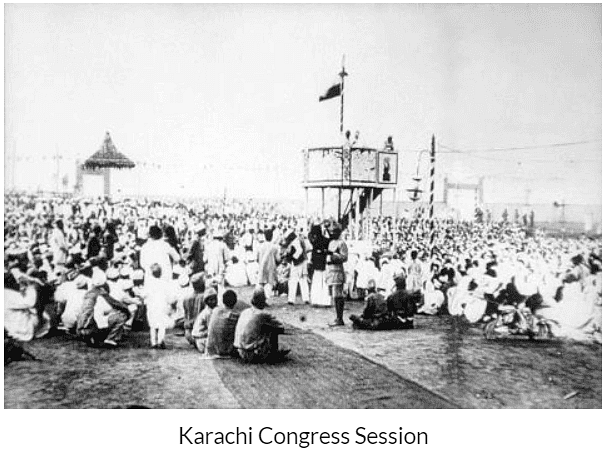
Congress Resolutions at Karachi
- While disapproving of and dissociating itself from political violence, Congress admired the 'bravery’ and 'sacrifice' of the three martyrs.
- Delhi Pact or Gandhi-Irwin Pact was endorsed.
- The goal of purna swaraj was reiterated. Two resolutions were adopted which made the session particularly memorable.
Resolution on Fundamental Rights guaranteed
- Free speech and free press
- Right to form associations
- Right to assemble
- Universal adult franchise
- Equal legal rights irrespective of caste, creed, and sex
- The neutrality of the state in religious matters
- Free and compulsory primary education
- Protection to culture, language, the script of minorities and linguistic groups
Resolution on National Economic Programme included
- Substantial reduction in rent and revenue in the case of landholders and peasants
- Exemption from rent for uneconomic holdings
- Relief from agricultural indebtedness control of usury
- Better conditions of work including a living wage, limited hours of work, and protection of women workers in the industrial sector
- Right to workers and peasants to form unions
- State ownership and control of key industries, mines, and means of transport.
The Round Table Conferences
The Viceroy of India, Lord Irwin, and the Prime Minister of Britain, Ramsay MacDonald, agreed that a round table conference should be held, as the recommendations of the Simon Commission report were clearly inadequate.
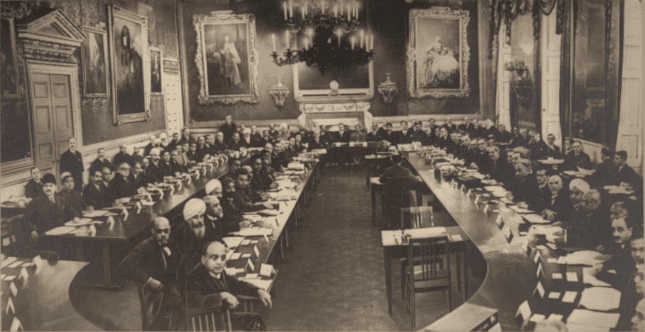
First Round Table Conference
- First Round Table Conference was held in London between November 1930 and January 1931. It was opened officially by King George V on November 12, 1930, and chaired by Ramsay MacDonald.
- Outcome- Nothing much was achieved at the conference. It was generally agreed that India was to develop into a federation
Second Round Table Conference
- The Second Round Table Conference was held in London from September 7, 1931, to December 1, 1931. The Indian National Congress nominated Gandhi as its sole representative. Not much was expected from the conference because of the following reasons.
- By this time, Lord Irwin had been replaced by Lord Willingdon as viceroy in India. Just before the conference began, the Labour government in England had been replaced by a National Government.
- Right-Wing or Conservatives in Britain led by Churchill strongly objected to the British government negotiating with the Congress on an equal basis. They, instead, demanded a strong government in India. The Prime Minister, Ramsay MacDonald headed the Conservative-dominated cabinet with a weak and reactionary secretary of state for India, Samuel Hoare.
- At the conference, Gandhi claimed to represent all people of India against imperialism. The other delegates, however, did not share this view.
- Gandhi pointed out that there was a need for a partnership between Britain and India on the basis of equality. He put forward the demand for the immediate establishment of a responsible government at the center as well as in the provinces.
- The session soon got deadlocked on the question of the minorities. All these came together in a 'Minorities Pact’.
- Princes were also not too enthusiastic about a federation.
Outcome
lack of agreement among the many delegate groups meant that no substantial results regarding India's constitutional future would come out of the conference.
The session ended with MacDonald’s announcement of
- Two Mulsim majority provinces—North-West Frontier Province (NWFP) and Sindh;
- the setting up of an Indian Consultative Committee;
- setting up of three expert committees—finance, franchise, and states; and
- The prospect of a unilateral British Communal Award if Indians failed to agree.
Third Round Table Conference
- Third Round Table Conference, held between November 17, 1932, and December 24, 1932, was not attended by the Indian National Congress and Gandhi.
- Recommendations were published in a White Paper in March 1933 and debated in the British Parliament afterward. A Joint Select Committee was formed to analyze the recommendations and formulate a new Act for India, and that committee produced a draft Bill in February 1935 which was enforced as the Government of India Act of 1935 in July 1935.
Civil Disobedience Resumed
On the failure of the second Round Table Conference, the Congress Working Committee decided on December 29, 1931, to resume the civil disobedience movement.
During the Truce Period (March-December 1931)
- In the United Provinces, the Congress had been leading a movement for a rent reduction and against summary evictions,
- In the NWFP, severe repression had been unleashed against the Khudai Khidmatgars
- In Bengal, draconian ordinances and mass detentions had been used in the name of fighting terrorism.
- In September 1931, there was a firing incident on political prisoners in Hijli Jail.
Changed Government Attitude After Second RTC-
- There were three main considerations in British policy:
- Gandhi would not be permitted to build up the tempo for a mass movement again.
- Goodwill of the Congress was not required, but the confidence of those who supported the British against the Congress—government functionaries, loyalists, etc.—was very essential.
- The national movement would not be allowed to consolidate itself in rural areas.
Government Action
- A series of repressive ordinances were issued which ushered in a virtual martial law, though under civilian control, or a 'Civil Martial Law’.
Popular Response
- People responded with anger. Though unprepared, the response was massive. Finally, in April 1934, Gandhi decided to withdraw the civil disobedience movement.
Communal Award and Poona Pact
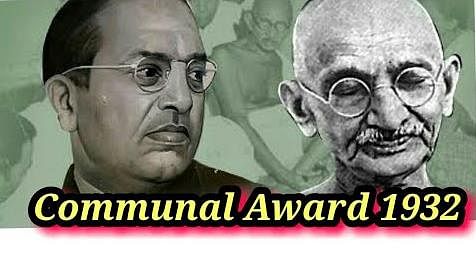 Communal Award was announced by the British prime minister, Ramsay MacDonald, on August 16, 1932. Ramsay MacDonald, who had chaired the committee on minorities, offered to mediate on the condition that the other members of the committee supported his decision. And, the outcome of this mediation was the Communal Award.
Communal Award was announced by the British prime minister, Ramsay MacDonald, on August 16, 1932. Ramsay MacDonald, who had chaired the committee on minorities, offered to mediate on the condition that the other members of the committee supported his decision. And, the outcome of this mediation was the Communal Award.
Main Provisions of the Communal Award
- An arrangement for the depressed classes was to be made for a period of 20 years.
- In the provincial legislatures, the seats were to be distributed on a communal basis.
- Existing seats of the provincial legislatures were to be doubled.
- Muslims, wherever they were in minority, were to be granted a weightage.
- Except in the Northwest Frontier Province, 3 percent of seats were to be reserved for women in all provinces.
- Depressed classes to be declared/accorded the status of minority.
- Depressed classes were to get ‘double vote, one to be used through separate electorates and the other to be used in the general electorates.
- In the province of Bombay, 7 seats were to be allocated for the Marathas.
Congress Stand
- Though opposed to separate electorates, the Congress was not in favor of changing the Communal Award without the consent of the minorities.
Gandhi's Response
- Gandhi saw the Communal Award as an attack on Indian unity and nationalism. And to press his demands, he went on an indefinite fast on September 20, 1932.
Poona Pact
- Signed by B.R. Ambedkar on behalf of the depressed classes on September 24, 1932, the Poona Pact abandoned the idea of separate electorates for the depressed classes.
- The seats reserved for the depressed classes were increased from 71 to 147 in provincial legislatures and to 18 percent of the total in the Central Legislature.
- The Poona Pact was accepted by the government as an amendment to the Communal Award.
Impact of Poona Pact on Dalits
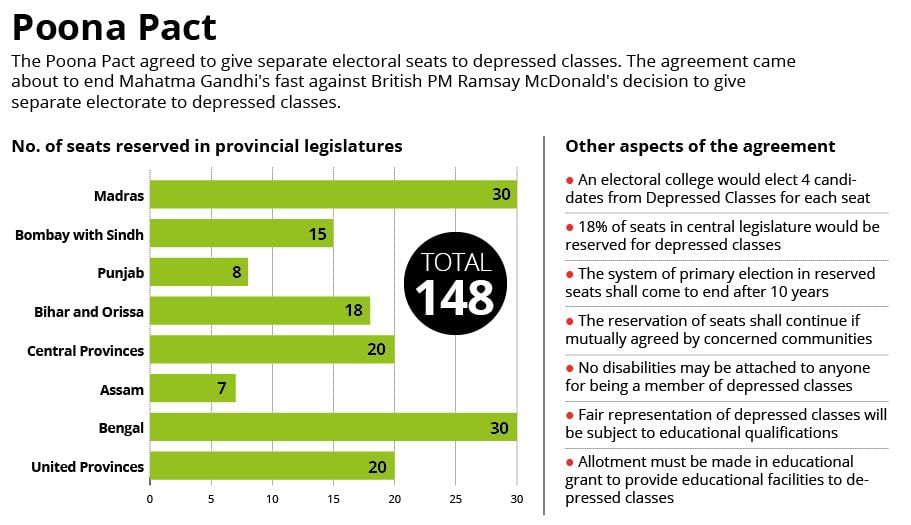
- The pact made the depressed classes political tools that could be used by the majoritarian caste Hindu organizations.
- It made the depressed classes leaderless as the true representatives of the classes were unable to win against the stooges who were chosen and supported by the caste Hindu organizations.
- This led to the depressed classes to submit to the status quo in political, ideological, and cultural fields and not being able to develop independent and genuine leadership to fight the Brahminical order.
- It subordinated the depressed classes into being part of the Hindu social order by denying them a separate and distinct existence.
- Poona Pact perhaps put obstructions in the way of an ideal society based on equality, liberty, fraternity, and justice.
- By denying to recognize the Dalits as a separate and distinct element in the national life, it pre-empted the rights and safeguards for the Dalits in the Constitution of independent India.
Joint Electorates and Its Impact on Depressed Classes
The provisions of the joint electorate gave the Hindu majority the virtual right to nominate members of the scheduled castes who were prepared to be the tools of the Hindu majority. The working committee of the federation, thus, demanded the restoration of the system of separate electorates, and nullification of the system of joint electorates and reserved seats.
Gandhi’s Harijan Campaign and thoughts on Caste
- Gandhi gave up all his other preoccupations and launched a whirlwind campaign against untouchability first from jail and then, after his release in August 1933, from outside jail.
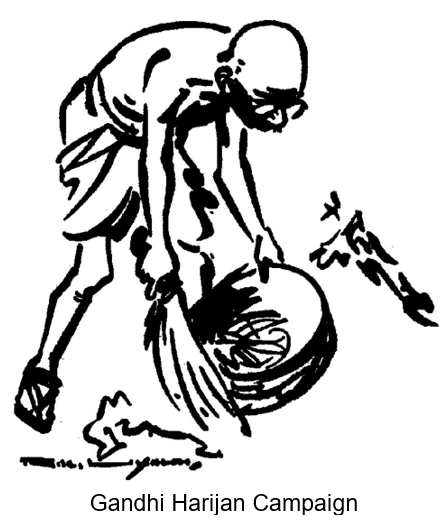
- While in jail, he set up the All India Anti-Untouchability League in September 1932 and started the weekly Harijan in January 1933. Starting from Wardha, he conducted a Harijan tour of the country in the period from November 1933 to July 1934, covering 20,000 km, collecting money for his newly set up Harijan Sevak Sangh, and propagating removal of untouchability in all its forms.
- He undertook two fasts— on May 8 and August 16, 1934, Gandhi was attacked by orthodox and reactionary elements. The government obliged them by defeating the Temple Entry Bill in August 1934.
- Throughout his Harijan tour, social work, and fasts, Gandhi stressed certain themes:
(i) He put forward a damning indictment of Hindu society for the kind of oppression practiced on Harijans.
(ii) He called for the total eradication of untouchability symbolized by his plea to throw open temples to the untouchables.
(iii) He stressed the need for caste Hindus to do 'penance' for untold miseries inflicted on Harijans. He said, "'Hinduism dies if untouchability lives, untouchability has to die if Hinduism is to live.”
(iv) His entire campaign was based on principles of humanism and reason. He said that the Shastras do not sanction untouchability, and if they did, they should be ignored as it was against human dignity. - Gandhi felt that whatever the limitations and defects of the varnashrama system, there was nothing sinful about it.
- Untouchability, Gandhi felt, was a product of distinctions of high and low and not of the caste system itself.
- Impact of the Campaign-Gandhi repeatedly described the campaign as being primarily meant to purify Hinduism and Hindu society.
Ideological Differences and Similarities between Gandhi and Ambedkar
- Gandhi, the principal architect of the Indian freedom struggle, and B.R. Ambedkar, the principal architect of the Constitution of independent India
- The burning of foreign cloth by Gandhi and the burning of Manusmriti by Ambedkar are not to be seen as mere acts of sentiment. Rather, foreign cloth and Manusmriti represented the bondage and slavery for India.

- Gandhi believed that freedom was never to be bestowed but to be wrested from the authority by the people who desire it, whereas Ambedkar expected the bestowing of freedom by the imperial rulers.
- Ambedkar advocated a parliamentary system of government for independent India, but Gandhi had very little respect for the parliamentary system of governance.
- Gandhi believed that democracy tends to get converted into mass democracy with a propensity for domination by leaders. Ambedkar was inclined towards mass democracy as it could act as a pressure on the government with the advancement of the oppressed people.
- Ambedkar s politics tended to highlight the aspect of Indian disunity whereas Gandhian politics tried to show the aspect of Indian unity.
- According to Ambedkar absolute sovereign power of the State would annihilate the spirit and personality of an individual. Gandhi, in fact, believed in the least governance being the best governance.
- Gandhi and Ambedkar differed greatly in their views concerning the mechanization of production and utilization of heavy machinery.
- To Gandhi, untouchability was one of the many problems confronted by Indian society. To Ambedkar, untouchability was the major problem that captured his sole attention.
- Ambedkar wanted to solve the problem of untouchability through laws and constitutional methods, whereas Gandhi treated untouchability as a moral stigma.
|
111 videos|466 docs|173 tests
|
FAQs on Spectrum Summary: Civil Disobedience Movement & Round Table Conferences - History for UPSC CSE
| 1. What was the Run-up to the Civil Disobedience Movement? |  |
| 2. What was the Salt Satyagraha? |  |
| 3. What was the Gandhi-Irwin Pact? |  |
| 4. What were the Round Table Conferences? |  |
| 5. What was the impact of Joint Electorates on the Depressed Classes? |  |

|
Explore Courses for UPSC exam
|

|


















